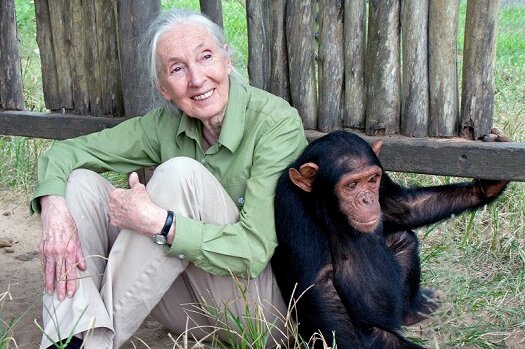Jane Goodall
Episode #9 of the course Ten significant women in science by James Wareing
Today, we move away from the laboratory to the middle of the Tanzanian rainforest to learn of the work of Jane Goodall. Born in London in 1934 she left school at the age of 18 and did not initially go to university. Many of the scientists we have read of so far have had distinguished academic careers from a very early age before excelling at university. Goodall, however, left school to work as a secretary. What follows is a remarkable career that led to her becoming the most renowned expert on chimpanzees in the world, often described as “the woman who redefined man.”
What Did She Do?
She met the anthropologist, Louis Leakey, in Tanzania while working as a film production assistant. While hiking in the rainforest she observed a chimpanzee making a tool from a branch to access and eat termites. This was a fascinating observation, previously unseen, that challenged the previous intellectual limitations ascribed to non-human animals. Perhaps this can be attributed in some way to her non-scientific background, unhindered by preconceived ideas and competing theories. This began her observations in the Gombe Stream National Park, focusing on the behavioral attributes of the primates. What she established changed the way in which we think about chimpanzees. She determined that they had complex social interactions, including strong maternal bonds, quasi-political systems, and outward displays of emotion such as hugging.
To gain more credibility and respect for her ideas, she returned to England in 1961 to do her Ph.D. at Cambridge University, something she was accepted to do without having completed a degree (a rare occurrence). She continued to challenge conventional scientific practice in her work, gaining criticism for naming the chimpanzees she was monitoring, as opposed to numbering them (which was thought to increase objectivity). This was at a time when the anthropomorphizing of animals was a frowned-upon practice by many.
She remained there almost exclusively for 15 years before setting up the Jane Goodall Institute. The institute aims to protect primates around the world, tackling some of the biggest threats such as trafficking and deforestation. In the late 1980s, she turned from science to activism, aiming to halt the destruction of the habitats that were threatening primate species around the world.
Legacy and Challenges Faced as a Woman
Goodall says that when she was young her family would belittle her ideas of turning to science. She has described her family’s reaction to her announcement that she wanted to study in the jungles of Africa thus: “Jane gets real. You know girls don’t do this kind of thing, living with animals in the forest.” Even the idea of her going to Tanzania alone, as a young woman, was banned by the British authorities. They insisted that she had to take an escort with her (she chose her mother). Headlines, focussing on her gender as opposed to her scientific value, predictably followed her work such as Comely Miss Spends Her Time Eyeing Apes.
However, she considers her gender actually to have helped her when carrying out the work. She believes that white men were trusted less by local people in post-colonial Tanzania. As a result, she felt that she was able to build a better rapport and gain confidence in her work more effectively. In fact, the anthropologist who first gave her the role, Louis Leakey, seems to agree. He purposefully chose three women to carry out observation as he thought that they would make for more attentive observers.
Tomorrow, in our final lesson, we shall learn about Jennifer Doudna and her achievements, which have significant ramifications for our future societies.
Recommended book
In the Shadow of Man by Jane Goodall
Share with friends


